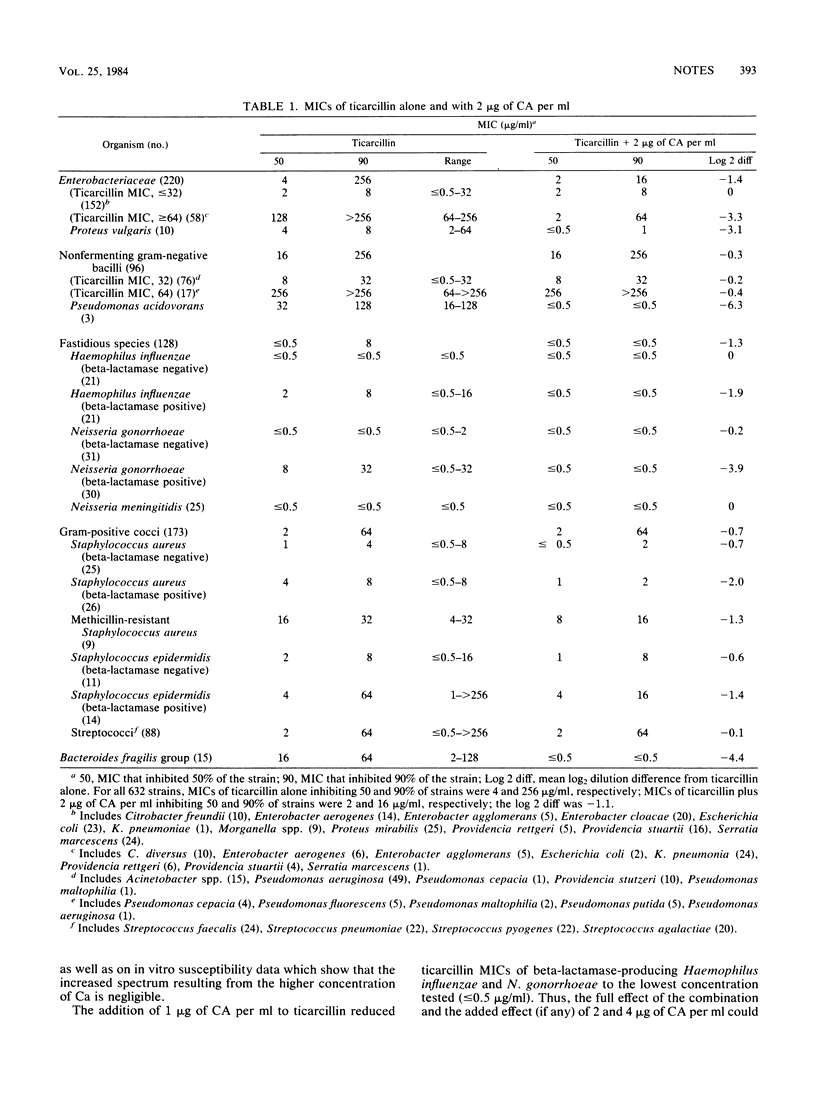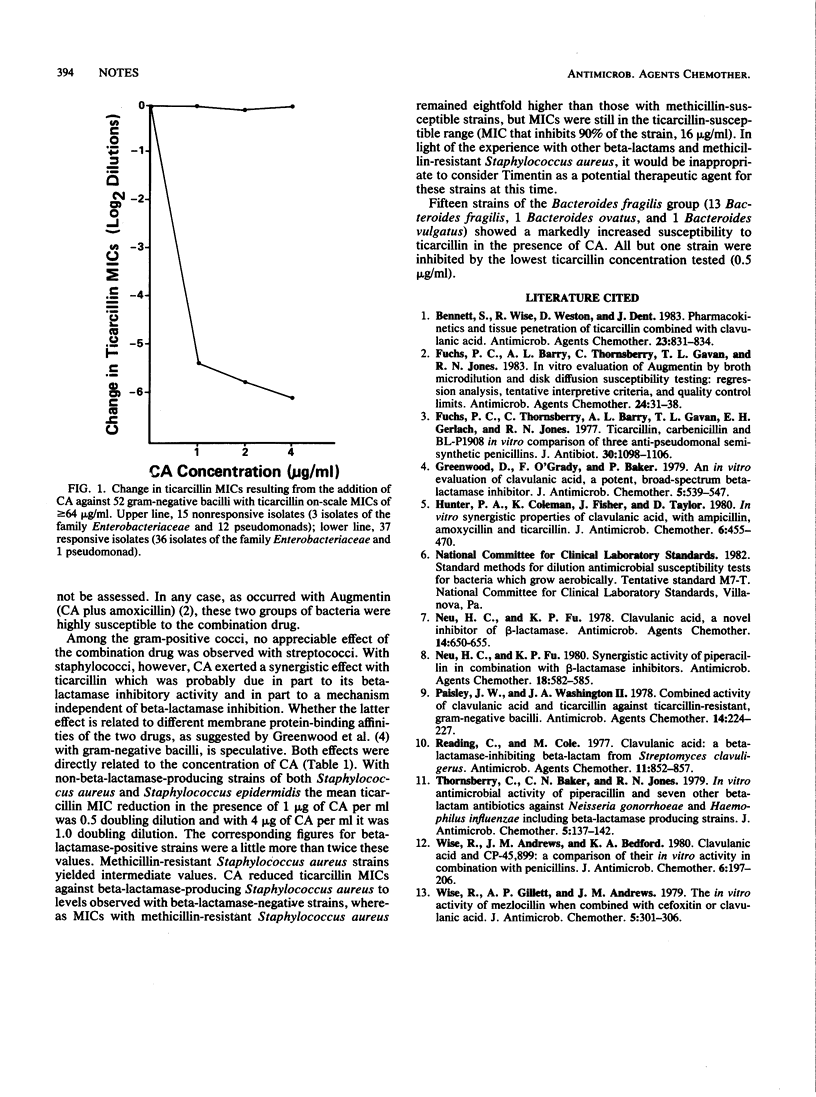Abstract
A total of 632 clinical bacterial isolates were tested for susceptibility to twofold dilutions of ticarcillin alone and in combination with 1, 2, and 4 micrograms of clavulanic acid (CA) (Timentin) per ml by a reference microdilution method. With the addition of CA, ticarcillin MICs were reduced eightfold or greater with 54 of 59 (92%) strains of the family Enterobacteriaceae with ticarcillin MICs of greater than or equal to 64 micrograms/ml. The inhibitory effect of CA on pseudomonads was minimal. Ticarcillin MICs for beta-lactamase-producing Haemophilus influenzae, Neisseria gonorrhoeae, and most Staphylococcus aureus were reduced to less than or equal to 0.5 micrograms/ml when CA was added. For dilution susceptibility testing of ticarcillin-clavulanic acid, dilutions of ticarcillin combined with 2 micrograms of CA per ml is suggested.
Full text
PDF


Selected References
These references are in PubMed. This may not be the complete list of references from this article.
- Bennett S., Wise R., Weston D., Dent J. Pharmacokinetics and tissue penetration of ticarcillin combined with clavulanic acid. Antimicrob Agents Chemother. 1983 Jun;23(6):831–834. doi: 10.1128/aac.23.6.831. [DOI] [PMC free article] [PubMed] [Google Scholar]
- Fuchs P. C., Barry A. L., Thornsberry C., Gavan T. L., Jones R. N. In vitro evaluation of Augmentin by broth microdilution and disk diffusion susceptibility testing: regression analysis, tentative interpretive criteria, and quality control limits. Antimicrob Agents Chemother. 1983 Jul;24(1):31–38. doi: 10.1128/aac.24.1.31. [DOI] [PMC free article] [PubMed] [Google Scholar]
- Fuchs P. C., Thornsberry C., Barry A. L., Gavan T. L., Gerlach E. H., Jones R. N. Ticarcillin, carbenicillin and BL-P1908. In vitro comparison of three anti-pseudomonal semisynthetic penicillins. J Antibiot (Tokyo) 1977 Dec;30(12):1098–1106. doi: 10.7164/antibiotics.30.1098. [DOI] [PubMed] [Google Scholar]
- Greenwood D., O'Grady F., Baker P. An in vitro evaluation of clavulanic acid, a potent, broad-spectrum beta-lactamase inhibitor. J Antimicrob Chemother. 1979 Sep;5(5):539–547. doi: 10.1093/jac/5.5.539. [DOI] [PubMed] [Google Scholar]
- Hunter P. A., Coleman K., Fisher J., Taylor D. In vitro synergistic properties of clavulanic acid, with ampicillin, amoxycillin and ticarcillin. J Antimicrob Chemother. 1980 Jul;6(4):455–470. doi: 10.1093/jac/6.4.455. [DOI] [PubMed] [Google Scholar]
- Neu H. C., Fu K. P. Clavulanic acid, a novel inhibitor of beta-lactamases. Antimicrob Agents Chemother. 1978 Nov;14(5):650–655. doi: 10.1128/aac.14.5.650. [DOI] [PMC free article] [PubMed] [Google Scholar]
- Neu H. C., Fu K. P. Synergistic activity of piperacillin in combination with beta-lactamase inhibitors. Antimicrob Agents Chemother. 1980 Oct;18(4):582–585. doi: 10.1128/aac.18.4.582. [DOI] [PMC free article] [PubMed] [Google Scholar]
- Paisley J. W., Washington J. A., 2nd Combined activitiy of clavulanic acid and ticarcillin against ticarcillin-resistant, gram-negative bacilli. Antimicrob Agents Chemother. 1978 Aug;14(2):224–227. doi: 10.1128/aac.14.2.224. [DOI] [PMC free article] [PubMed] [Google Scholar]
- Reading C., Cole M. Clavulanic acid: a beta-lactamase-inhiting beta-lactam from Streptomyces clavuligerus. Antimicrob Agents Chemother. 1977 May;11(5):852–857. doi: 10.1128/aac.11.5.852. [DOI] [PMC free article] [PubMed] [Google Scholar]
- Thornsberry C., Baker C. N., Jones R. N. In vitro antimicrobial activity of piperacillin and seven other beta-lactam antibiotics against Neisseria gonorrhoeae and Haemophilus influenzae, including beta-lactamase producing strains. J Antimicrob Chemother. 1979 Mar;5(2):137–142. doi: 10.1093/jac/5.2.137. [DOI] [PubMed] [Google Scholar]
- Wise R., Andrews J. M., Bedford K. A. Clavulanic acid and CP-45,899: a comparison of their in vitro activity in combination with penicillins. J Antimicrob Chemother. 1980 Mar;6(2):197–206. doi: 10.1093/jac/6.2.197. [DOI] [PubMed] [Google Scholar]
- Wise R., Gillett A. P., Andrews J. M. The in vitro activity of mezlocillin when combined with cefoxitin or clavulanic acid. J Antimicrob Chemother. 1979 May;5(3):301–306. doi: 10.1093/jac/5.3.301. [DOI] [PubMed] [Google Scholar]


